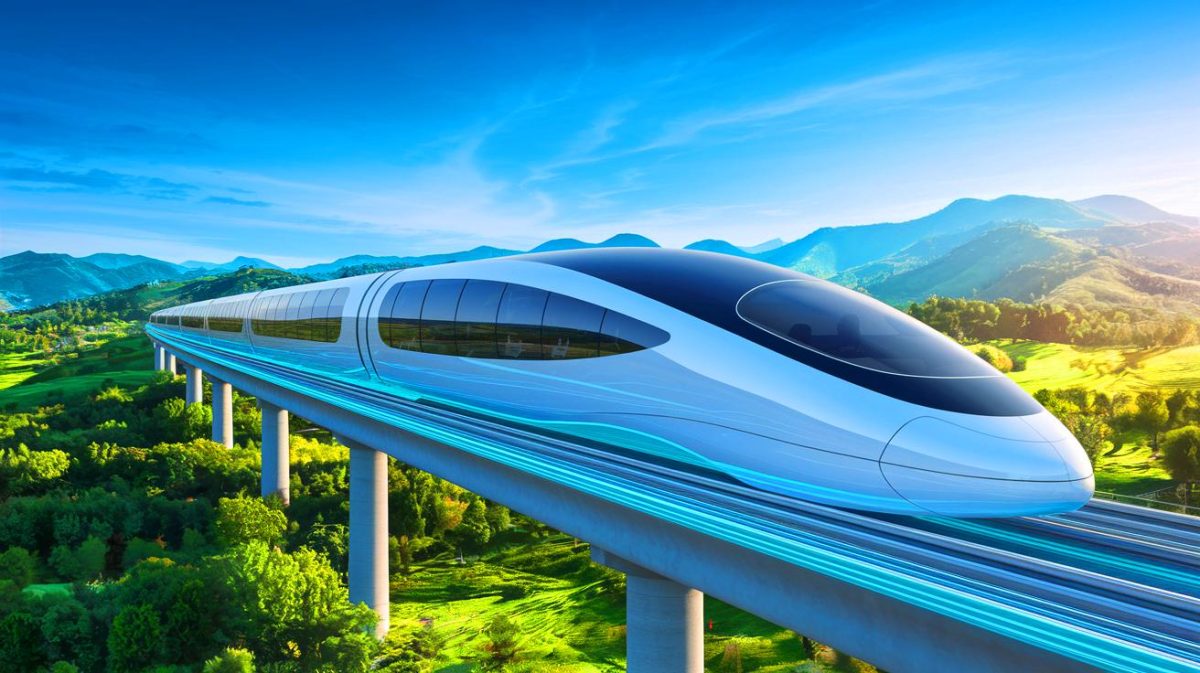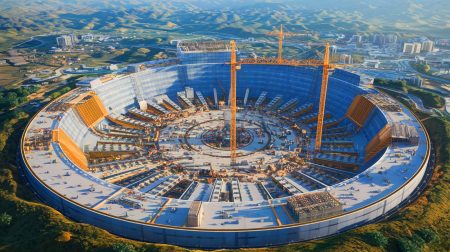| IN A NUTSHELL |
|
The development of the Hyperloop in China signifies a major leap forward in high-speed transportation. This ambitious project, which aims to achieve speeds comparable to those of airplanes, promises to revolutionize how we travel. However, it also raises questions about its long-term feasibility and economic implications. With recent tests conducted in Shanxi Province, China is poised to transform rail transport. Let’s delve into the fascinating details of this project and explore the challenges it may face in the future.
An Unprecedented Technological Feat
China has recently reached a significant milestone by conducting full-scale tests of its Hyperloop maglev in a two-kilometer-long tube. This test aimed to evaluate the integration of various train systems, a critical step for the project’s success. Although the exact speed achieved during the test has not been disclosed, the results have met the developers’ expectations. Several cutting-edge technologies were put to the test, including magnetic levitation navigation control, which allows the train to “fly” frictionlessly over the tracks.
This test marks an important milestone for the project, demonstrating China’s ability to integrate complex technologies into an advanced transportation system. The use of magnetic levitation is particularly noteworthy, as it eliminates friction, enabling exceptional speeds. The potential to achieve interurban travel in record time could transform the transportation landscape in China and beyond, paving the way for a new era of rapid and efficient mobility.
The Ambitious Goals of the Project
Chinese engineers have high aspirations for their Hyperloop system. They hope this technology will allow trains to “fly on the ground” at speeds comparable to airplanes, offering a fast and efficient alternative to air travel. The project results from a collaboration between the Shanxi provincial government and the China Aerospace Science and Industry Corporation (CASIC), two major players in China’s technological development.
The test line located in Datong was constructed in record time, from April 2022 to November 2023, illustrating China’s commitment to this project. Developers claim that this test set a new speed record, although the exact figure remains unknown. This rapid construction and development underscore the seriousness with which China approaches this project. The objectives are clear: create a fast and reliable transportation system that could transform the country’s rail network.
A Promising Yet Uncertain Future
The potential of the Hyperloop to connect Chinese megacities is immense. By drastically reducing travel time, it could transform urban mobility. For instance, the journey between Beijing and Shanghai could be reduced to just 90 minutes, revolutionizing interurban travel. This reduction in travel time is made possible by using magnetic levitation technology, which eliminates friction, and traveling in a low-pressure tube that reduces air resistance.
However, despite its promises, the project is not without challenges. Questions remain about the system’s feasibility on a large scale and the economic implications it may entail. The construction and maintenance costs of such infrastructure could be prohibitive, and the environmental impact of such advanced technology remains to be assessed. Nevertheless, the success of this project could well define the future of high-speed transportation in China and potentially worldwide.
The Challenges to Overcome
While the progress made thus far is impressive, several challenges must still be overcome for the Hyperloop to become a viable reality. The development and maintenance costs of such infrastructure are substantial, raising questions about the project’s long-term profitability. Furthermore, the environmental impact of constructing and operating the Hyperloop must be carefully evaluated to ensure sustainable development.
Establishing a Hyperloop network also requires creating an appropriate regulatory framework and the support of stakeholders, including local governments and private investors. Collaboration between different sectors is essential to overcome these obstacles. However, if these challenges can be addressed, the Hyperloop could transform transportation not only in China but also globally, offering a fast, efficient, and potentially eco-friendly means of long-distance travel.
As China continues to advance in developing its Hyperloop, the future of high-speed transportation looks promising. However, many challenges must still be addressed to turn this vision into reality. Will China succeed in overcoming these obstacles and setting a new standard for global rail transport?
Did you like it? 4.5/5 (29)









Wow, 90 minutes between Beijing and Shanghai? That’s faster than ordering takeout! 😅
Can we trust these tests? What’s the safety record of this new technology?
What happens if there’s a power outage? How will the Hyperloop handle emergencies?
Is this a sign that trains will eventually replace short-distance flights? 🤔
In China (and Japan, Korea, Spain etc), high speed rail has ALREADY replaced plane in short distance travel!! Or at least orovides a viable alternative!
Let’s hope they maintain these systems better than some of their other projects…
How does it compare to Elon Musk’s Hyperloop concept?
Thank you for the fascinating article! Can’t wait to see how this develops. 🌟
90 minutes? That’s barely enough time for a nap! 💤
Will this be open to international travelers or just for local commuters?
I wonder how this affects the airline industry in China. ✈️
Sounds like a dream come true! But I’m skeptical about the costs involved.
What are the economic benefits expected from this project?
Hope to see a similar project in Europe someday!
Does this mean I’ll get my packages delivered faster too? 😂
I’m curious about the noise levels. Will it be quieter than traditional trains?
Yes because it’s low pressure so noise can’t propagate!
How much will tickets cost? I hope it’s affordable for the average person!
Why haven’t they disclosed the exact speed achieved during the tests?
This could be a game-changer for business travelers! 🧳
So, when can we expect the first passenger rides?
If successful, this could revolutionize global travel. Fingers crossed! 🤞
Are there any plans to expand this technology to other cities in China?
An article on Hyperloop and no mention of Elon Musk? Unbelievable.
How does maglev tech work exactly? Can someone explain?
Magnets are used to lift the train above the track, I believe acceleration can be achieved by moving the magnetic field, but they are probably using something a bit more advanced. There was a magkev train for years operating between Birmingham International rail station and Birmingham Airport in the UK.
Hyperlink is different as it uses low pressure in a tunnel and maintaining low pressure over 100s of miles is what will make or break it, its bad enough pumping down a small mass spectrometer down to low pressure, trust me I did it for a living!
Is it just me, or does this sound too good to be true?
What kind of job opportunities will this project create?
Is this more efficient than Japan’s Shinkansen? 🚅
Sounds amazing, but what about the environmental impact of constructing such infrastructure?
Another impressive feat by China! 🚄
Hello, this is NOT the same hyperloop concept where the train travels in a vacuum tube ; it just a high tech high speed train.
Just don’t let dreamers think that the original “hyperloop” works; it is almost impossible to get that concept working because it is so so prohibitively expensive as well as technically challenging that it’s just not commercially viable.
Did they really achieve Boeing speeds? That’s mind-blowing! 😮
The author seems really hung up on “Impacts” & “maintenance.” All photos I’ve seen featured an elevated structure (minimal ground impact) & if is truly is maglev, that means no noise from engines, as it’s ‘chasing’ an electronic magnet. Swift, silent, off the ground, & – perhaps – in a particularly evacuated vacuum tube sounds like NO impact. What am I missing?
Why don’t we have this tech in the US yet? We’re falling behind.
This sounds like the plot of a sci-fi movie! Is it really happening? 🤖
Very interesting, but the illustration is confusing, It should be a vacuum tube
This hyperloop thingy is overhype dream, it’s simply not going to happen because it’s not just profitability & viability, it’s the engineering technology that is almost improbable if not impossible!
It’s just the dreams of ego-maniacs like Musk who wants a wow3 kind of project for boasting purposes. One must remember we are not talking about a single device like a ship, submarine or space-ship which is likely achievable despite the costs of a single or few of them, but thousands or hundreds of thousand km of the tubes, the cost is simply unfathomable – let’s leave it to ego-dreamers and ignorant dreams; also let’s not give them false hopes,
Lol so funny many people skeptical about Chinese projects or MEGA projects. When they say something they really mean it. Like come on the Chinese govt will probably sponsor the COST because they have too much money since they don’t start endless wars everywhere else. Affordable?? It’s China the government there MAKE SURE. The average people can afford it if not why even bother build the infrastructure. This is what a RESOLVE mean. They all together put their time money energy to achieve common goal. If the project delayed who is gonna lose? EVERYONE losing. Guess the Asian mentality is different than other cultures.